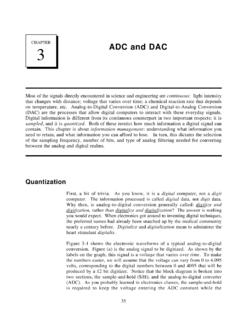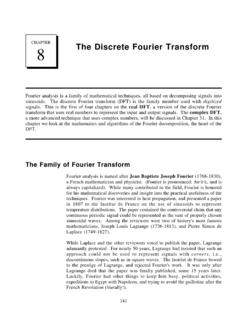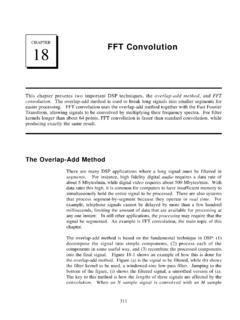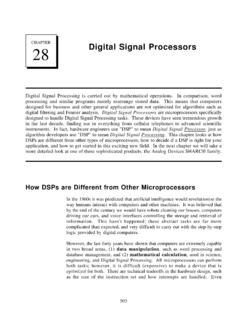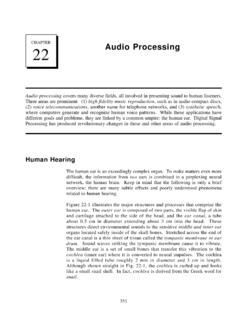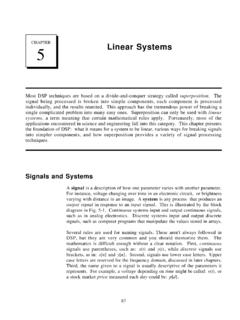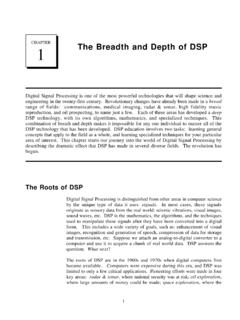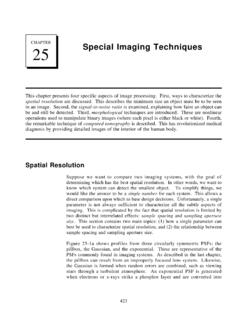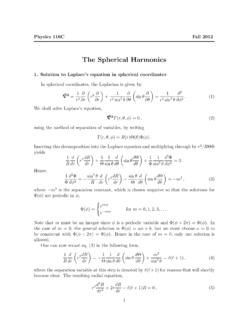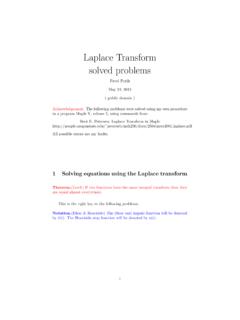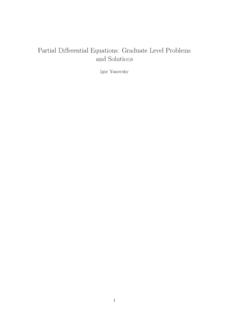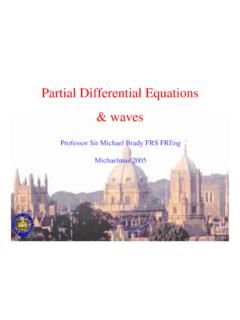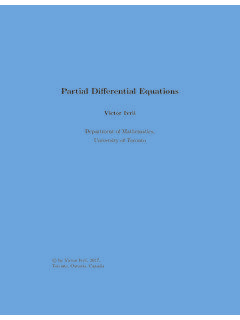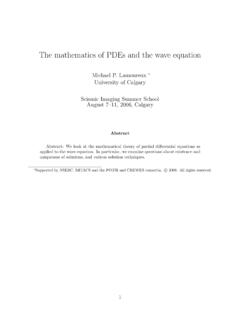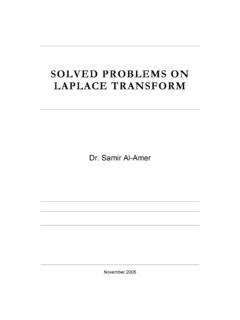Transcription of CHAPTER
1 CHAPTER . The laplace Transform 32. The two main techniques in signal processing, convolution and Fourier analysis, teach that a linear system can be completely understood from its impulse or frequency response. This is a very generalized approach, since the impulse and frequency responses can be of nearly any shape or form. In fact, it is too general for many applications in science and engineering. Many of the parameters in our universe interact through differential equations. For example, the voltage across an inductor is proportional to the derivative of the current through the device. Likewise, the force applied to a mass is proportional to the derivative of its velocity. Physics is filled with these kinds of relations. The frequency and impulse responses of these systems cannot be arbitrary, but must be consistent with the solution of these differential equations.
2 This means that their impulse responses can only consist of exponentials and sinusoids. The laplace transform is a technique for analyzing these special systems when the signals are continuous. The z- transform is a similar technique used in the discrete case. The Nature of the s-Domain The laplace transform is a well established mathematical technique for solving differential equations. It is named in honor of the great French mathematician, Pierre Simon De laplace (1749-1827). Like all transforms, the laplace transform changes one signal into another according to some fixed set of rules or equations. As illustrated in Fig. 32-1, the laplace transform changes a signal in the time domain into a signal in the s-domain, also called the s- plane. The time domain signal is continuous, extends to both positive and negative infinity, and may be either periodic or aperiodic.
3 The laplace transform allows the time domain to be complex; however, this is seldom needed in signal processing. In this discussion, and nearly all practical applications, the time domain signal is completely real. As shown in Fig. 32-1, the s-domain is a complex plane, , there are real numbers along the horizontal axis and imaginary numbers along the vertical axis. The distance along the real axis is expressed by the variable, F, a lower 581. 582 The Scientist and Engineer's Guide to Digital Signal Processing case Greek sigma. Likewise, the imaginary axis uses the variable, T , the natural frequency. This coordinate system allows the location of any point to be specified by providing values for F and T. Using complex notation, each location is represented by the complex variable, s, where: s ' F% jT. Just as with the Fourier transform, signals in the s-domain are represented by capital letters.
4 For example, a time domain signal, x (t) , is transformed into an s- domain signal, X (s) , or alternatively, X (F,T) . The s-plane is continuous, and extends to infinity in all four directions. In addition to having a location defined by a complex number, each point in the s-domain has a value that is a complex number. In other words, each location in the s-plane has a real part and an imaginary part. As with all complex numbers, the real & imaginary parts can alternatively be expressed as the magnitude & phase. Just as the Fourier transform analyzes signals in terms of sinusoids, the laplace transform analyzes signals in terms of sinusoids and exponentials. From a mathematical standpoint, this makes the Fourier transform a subset of the more elaborate laplace transform. Figure 32-1 shows a graphical description of how the s-domain is related to the time domain.
5 To find the values along a vertical line in the s-plane (the values at a particular F), the time domain signal is first multiplied by the exponential curve: e & F t . The left half of the s-plane multiplies the time domain with exponentials that increase with time ( F < 0 ), while in the right half the exponentials decrease with time ( F > 0 ). Next, take the complex Fourier transform of the exponentially weighted signal. The resulting spectrum is placed along a vertical line in the s-plane, with the top half of the s-plane containing the positive frequencies and the bottom half containing the negative frequencies. Take special note that the values on the y-axis of the s-plane ( F ' 0 ) are exactly equal to the Fourier transform of the time domain signal. As discussed in the last CHAPTER , the complex Fourier Transform is given by: 4. m X (T) ' x(t ) e & jT t dt &4.
6 This can be expanded into the laplace transform by first multiplying the time domain signal by the exponential term: 4. m X (F, T) ' [ x (t ) e & F t ] e & jTt d t &4. While this is not the simplest form of the laplace transform, it is probably the best description of the strategy and operation of the technique. To CHAPTER 32- The laplace Transform 583. 2. x(t). 1. STEP 1. Amplitude Start with the time domain signal 0. called x(t). -1. -2. STEP 2 -4 -3 -2 -1 0 1 2 3 4. Multiply the time domain signal by Time an infinite number of exponential curves, each with a different decay constant, F. That is, calculate the signal: x(t) e & Ft for each value of F. from negative to positive infinity. F = -3 F = -2 F = -1 F= 0 F= 1 F= 2 F= 3. STEP 3. Take the complex Fourier Transform of each exponentially weighted time domain signal. That is, calculate: 4. m [ x (t ) e & Ft ] e & jTt d t &4.
7 For each value of F from negative to 5. positive infinity. 4. X(s). 3. Positive Imaginary axis ( jT). STEP 4 2 Frequencies Arrange each spectrum along a vertical line in the s-plane. The 1. positive frequencies are in the 0. upper half of the s-plane while the -1. negative frequencies are in the lower half. -2 Negative -3 Frequencies -4. -5. -5 -4 -3 -2 -1 0 1 2 3 4 5. Real axis (F) spectrum for F = 3. Increasing Decreasing Exponentials Exponentials FIGURE 32-1. The laplace transform. The laplace transform converts a signal in the time domain, x(t) , into a signal in the s-domain, X (s) or X(F, T) . The values along each vertical line in the s-domain can be found by multiplying the time domain signal by an exponential curve with a decay constant F, and taking the complex Fourier transform. When the time domain is entirely real, the upper half of the s-plane is a mirror image of the lower half.
8 584 The Scientist and Engineer's Guide to Digital Signal Processing place the equation in a shorter form, the two exponential terms can be combined: 4. m X (F, T ) ' x (t ) e &(F % jT )t d t &4. Finally, the location in the complex plane can be represented by the complex variable, s, where s ' F%jT . This allows the equation to be reduced to an even more compact expression: EQUATION 32-1. The laplace transform. This equation 4. m defines how a time domain signal, x (t) , is related to an s-domain signal, X (s) . The s- X (s) ' x(t ) e &s t dt domain variables, s, and X( ) , are complex. &4. While the time domain may be complex, it is usually real. This is the final form of the laplace transform, one of the most important equations in signal processing and electronics. Pay special attention to the term: e & st , called a complex exponential. As shown by the above derivation, complex exponentials are a compact way of representing both sinusoids and exponentials in a single expression.
9 Although we have explained the laplace transform as a two stage process (multiplication by an exponential curve followed by the Fourier transform), keep in mind that this is only a teaching aid, a way of breaking Eq. 32-1 into simpler components. The laplace transform is a single equation relating x (t). and X (s) , not a step-by-step procedure. Equation 32-1 describes how to calculate each point in the s-plane (identified by its values for F and T) based on the values of F , T, and the time domain signal, x (t) . Using the Fourier transform to simultaneously calculate all the points along a vertical line is merely a convenience, not a requirement. However, it is very important to remember that the values in the s-plane along the y-axis ( F ' 0 ) are exactly equal to the Fourier transform. As explained later in this CHAPTER , this is a key part of why the laplace transform is useful.
10 To explore the nature of Eq. 32-1 further, let's look at several individual points in the s-domain and examine how the values at these locations are related to the time domain signal. To start, recall how individual points in the frequency domain are related to the time domain signal. Each point in the frequency domain, identified by a specific value of T, corresponds to two sinusoids, cos (Tt ) and sin (Tt ) . The real part is found by multiplying the time domain signal by the cosine wave, and then integrating from -4 to 4. The imaginary part is found in the same way, except the sine wave is used. If we are dealing with the complex Fourier transform, the values at the corresponding negative frequency, - T , will be the complex conjugate (same real part, negative imaginary part) of the values at T. The laplace transform is just an extension of these same concepts.

